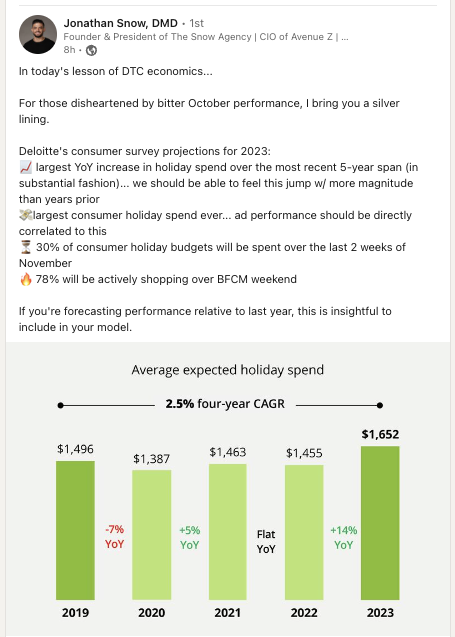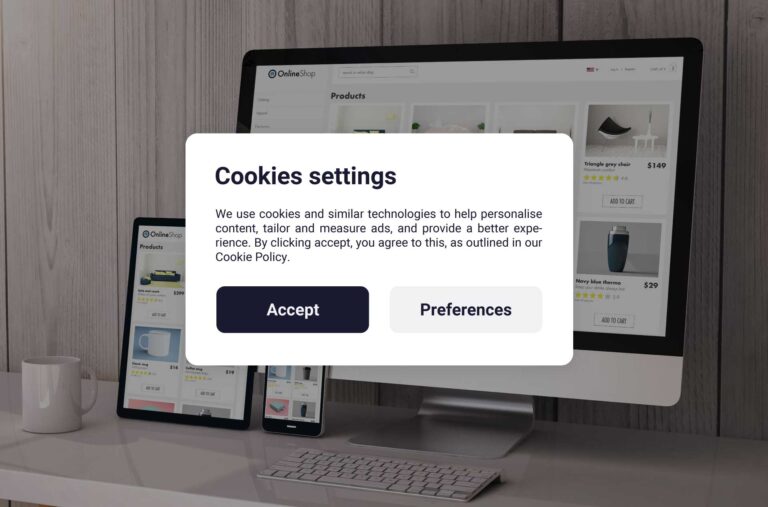The acronym ‘BFCM’ might sound like cryptic code, but we know that these four letters represent a golden opportunity. Black Friday and Cyber Monday (BFCM) are not just days; they’re phenomena that set the tone for the holiday shopping season. Every year, millions of shoppers eagerly await these events, wallets ready, for some of the best deals and most unique products. However, there’s been mixed feelings about this years’ performance. Jon Snow, Founder and President of The Snow Agency shared some exciting market data this week.

As we gear up for BFCM 2023, we asked industry experts, “What can merchants do now to capitalize on BFCM?”
Here’s what they shared with us…
Be strategic and focus on delivering an experience that builds trust.
Robin Dimond, CEO and Founder of Fifth & Cor, kicks off this article with amazing energy and shares a quick snapshot of best practices to capitalize on the holiday season.
Did you know that consumers shelled out a staggering $20 billion on Black Friday and Cyber Monday in the U.S. alone last year? And globally, this figure soared to an impressive $115 billion.
Such numbers drive home an undeniable fact: the significance of these two days is monumental. They don’t just influence quarterly revenue; they have the potential to shape your brand’s entire annual revenue trajectory.
However, it’s not just about getting lucky on these days. It’s about crafting a meticulous strategy:
- Set Clear Objectives: Start by defining what success looks like for your brand.
- Optimize Your Online Footprint: A seamless user experience can often be the difference between a conversion and an abandoned cart.
- Inventory Management: Stock up, but be smart about it. Predicting demand can help ensure you neither overstock nor run out of bestsellers.
- Cultivate Trust: This cannot be stressed enough. Use customer ratings, genuine reviews, and personalized marketing strategies to engender trust across every touchpoint.
- Transparent Policies: Ensure your shipping and return policies are easy to find and understand. The last thing you want is a disgruntled customer on the busiest shopping days of the year.
- Watch the Competition: Stay vigilant about what your competitors are offering and be ready to pivot your strategy, ensuring you always offer value.
Remember, the ultimate goal isn’t just about ringing up sales; it’s about forging lasting relationships with customers.
SEO is still King
Sam Wright, Managing Director at Blink SEO, shares why you should reject the “no one size fits all” mentality and leverage search data to optimize SEO for 2023.
Today’s business landscape is characterized by escalating costs and mounting market pressures. While many echo the sentiment that “no one size fits all”, a close interaction with numerous brands, agencies, and tech partners reveals shared challenges across similar business types.
At the heart of these challenges is understanding your business model and how it can best leverage SEO. For instance, a Shopify store with a smaller SKU count should prioritize product positioning, audience comprehension, and retention. In contrast, stores with a more expansive product range should direct their attention towards refining taxonomy and optimizing store architecture.
Why does this matter? Because data points to intriguing insights. A study from last year, spanning over 750,000 URLs from 50-60 brands, showed that 99.6% of all Black Friday related searches didn’t mention a brand name. Instead, they merged a category or subcategory with Black Friday terms, like “corner sofa Black Friday”. This indicates a strong trend: potential customers are not brand loyal during sales, but are deal-driven.
To tap into this pattern, we recommend a strategy:
- Leverage Past Data: Revisit last year’s search console data to pinpoint Black Friday terms. This can help anticipate the terms prospective customers will use this year.
- Spot the Trends: Even if you didn’t have a Black Friday campaign previously, look for impression data with terms like “sale”, “discount”, or “offer”. This can give you insights into probable Black Friday search patterns.
- Category-Specific Deals Pages: Instead of creating one generic Black Friday page, curate Black Friday deals pages for your main categories. This segmentation can lead to capturing various demand pockets.
- Plan Ahead: For SEO effectiveness, these deals pages need to be live well before Black Friday. Some sites use these pages for email captures, teasing the upcoming deals, ensuring a head start when Black Friday rolls in.
- Year-Round Relevance: This approach isn’t exclusive to Black Friday. Pages optimized for sales terms are perennially valuable, capturing high-intent commercial traffic throughout the year.
To conclude, while many focus on top-of-the-funnel strategies with blog content, capturing high-intent, commercial traffic can often offer better ROI. Understanding how customers search for deals, not just during BFCM but year-round, can pivot your strategy towards what genuinely drives conversions.
Think Outside Of The Box With DTC Strategic Partnerships
Dan Nistor, CEO at Vevol Media, emphasizes that as we approach the Black Friday campaigns of 2023, it’s essential to adopt a fresh perspective on your marketing strategies. In a landscape dominated by high-cost PPC and social ads, thinking differently is more crucial than ever.
Here’s our top recommendation: Dive into Strategic Partnerships.
- Why Strategic Partnerships? In the Direct-To-Consumer (DTC) realm, consider this: if you’re a makeup brand, aligning with a perfume brand targeting the same audience can unlock mutual benefits. This approach fosters cross-promotion, co-branding, and shared marketing efforts, amplifying the reach for both brands.
- The Rise of the Partnership Manager Role If your team doesn’t yet have a Strategic Partnership Manager or a Partnership Manager, now might be the perfect time to consider bringing one onboard. We’ve observed a surge in listings for this role, indicating its growing significance in the marketing sphere. By collaborating, brands can offer complementary value to their shared audiences, all while cutting down on individual marketing costs.
- Hiring Tip: When you’re sifting through potential candidates for this role, prioritize their track record in fostering relationships over their DTC experience. Their expertise in cultivating and nurturing professional partnerships is what will drive success in this strategy.
In summary, while PPC and social ads might be heavy on the pocket, strategic partnerships offer an affordable and effective alternative. Think innovatively, embrace collaborative marketing, and see where it takes your brand this Black Friday.
Nail Down Your Offer and Retarget
Josh Lothman, CEO at The Ads Tutor, is someone who has harnessed the power of paid ads to drive a whopping $1.4 million in sales for a brand within a single Black Friday. He shared some tried-and-tested strategies to ensure your Black Friday campaigns are a resounding success.
- The Power of Retargeting During Black Friday: consumers are primed and ready to shop. This is the perfect moment to retarget everyone – from previous buyers to those who engaged briefly with your brand’s content. However, tailor your messaging for each segment. The pitch that works for one stage in the sales funnel might not resonate in another.
- Craft a Standout Offer: In an advertising landscape flooded with discounts, your offer needs to rise above the noise. A mere 20% discount might get lost amidst the flurry of 30% to 50% off deals. Aim for an offer that’s so irresistible that shoppers are compelled to choose your brand.
- Kickstart Your Sales Early Why wait for the official Black Friday date? By launching your sales ahead of the curve, you position your brand to capture a significant market share before competitors even get started. Remember, nearly 60% of shoppers begin their holiday purchases as early as August or September. Moreover, ad costs trend upward from September, so introducing your brand earlier can be more cost-effective.
- Segment and Personalize: The key to driving conversions is personalization. Break down your audience into distinct segments, such as high-value customers or frequent shoppers, and craft offers tailored for them. For instance, consider offering premium products to your top-tier customers. This segmentation not only ensures higher conversion rates but also strengthens brand loyalty.
- Integrate Your Campaigns: Once you’ve segmented your audience, ensure you reach them through multiple touchpoints. Personalized email campaigns, retargeted ads, and segment-specific landing pages together create a holistic and impactful shopping experience.
Looking for more information:


